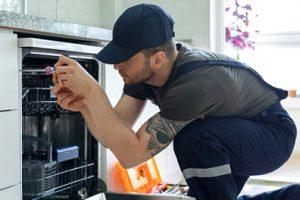A washing machine is an essential domestic appliance that helps us maintain clean and fresh clothing. However, like any other device, washing machines can encounter faults or malfunctions from time to time. Instead of immediately calling a maintenance specialist, attempt troubleshooting steps to identify and potentially fix the issue. This guide will lead you through a step-by-step process for diagnosing common problems with a faulty washing machine.
Disclaimer
Before we begin fixing problems, it is essential to note that this guide contains general advice and tips. Refer to the owner’s manual for your specific washing machine model, and exercise extreme care when handling electrical devices. If you are unsure or uneasy with any stages, you should seek professional guidance.

Step 1
Analyze the Symptoms The first step in appliance troubleshooting is identifying signs and eliminating potential causes. Ask yourself the following questions:
- Is the washing machine not turning on?
- Does it need to fill with water or drained?
- Is it making unusual noises?
- Is it not spinning or agitating correctly?
- Is it leaking water?
By understanding the symptoms, you can focus on the areas that need attention.
Step 2
Check Power and Connections If your washing machine isn’t turning on or showing any signs of life, the first thing to check is the power supply. Follow these steps:
- Verify that the power cord is correctly connected to the electrical outlet.
- Check the outlet’s functionality by clicking another device into it.
- Inspect the power cord for visible damage, such as cuts or broken wires.
- Proceed to the next step if the power supply and connections appear functional.
Step 3
Inspect Water Source and Pipes If your washing machine does not fill with water or the water pressure is insufficient, the water supply may be at fault. Follow a few verifications:
- Verify that the water sources that supply the machine are functional.
- Examine the water hoses for cracks, leakage, and blockages.
- If the inlet stages or filters are clogged, remove and clear them.
- If the water supply appears in good condition, proceed to the next step.
Step 4
Inspect and wash the Pump Filter. A blocked pump filter could be to blame if your washing machine isn’t draining or performing poorly. To clean the pump’s filter, proceed as follows:
- Locate the pump filter, usually at the bottom front or back of the machine.
- Place a towel or shallow container beneath the filter to catch any water.
- Unscrew or open the filter compartment and remove any debris or foreign objects.
- Clean the filter thoroughly and reinsert it back into the machine.
Step 5
Acknowledge Strange Noises If the washing machine makes a strange sound while operating, there may be a problem. Here are some frequent causes and potential remedies:
- Uneven loads: Ensure that the clothes inside the machine are distributed evenly.
- Loose components: Check if any screws or bolts are loose and tighten them if necessary.
- Worn-out or damaged parts: Inspect the drum, agitator, or motor for signs of wear and tear. If identified, consider contacting a professional for repair or replacement.
Step 6
Resolve Spinning and Acceleration Issues If your washing machine is not correctly spinning or disruptive, consider the following solutions:
- Overloading: Reduce cargo size to maintain the machine’s capacity.
- Check the machine’s stability and levelness on the ground. If necessary, adjust the leveling feet.
- Drive belt: Examine the drive belt for cracks or rips. Replace as needed.
- Lid switch: If your machine has a lid change, ensure it is engaging correctly. Test it by activating the button manually.
Step 7
Investigate Leaks A washing machine that leaks water can cause damage and pose safety risks. Follow the procedures below to detect and repair leaks:
- Examine the hoses: Check the inlet and drain hoses for cracks, bulges, or loose connections. Tighten or replace them as needed.
- Door or lid seal: Inspect the rubber gasket or seal around the door or lid for any tears or damage. Clean or replace if necessary.
- Tub or pump leaks: If the leak originates from the tub or pump, it may require professional assistance. Contact a repair technician to address these issues.
Conclusion
Fixing a faulty washing machine can save both money and time. Following this step-by-step guide, you can diagnose and remedy common appliance issues. However, safety should always come first; if you are unsure or uneasy with any of the steps, you should consult a professional. Regular maintenance, correct utilization, and timely repairs can prolong the washing machine’s life and keep it operating efficiently for many years.
FAQ: My washing machine is not filling with water. What should I do?
First, ensure that the water faucets supplying the device are turned on. Check the water hoses for any kinks, blockages, or leaks. Also, inspect the inlet screens or filters for clogging. If everything seems fine, the problem could be with the water inlet valve, which might need to be replaced.
FAQ: Why is my washing machine not spinning or agitating correctly?
Several factors can affect the spinning or agitation function. Start by checking if the load is balanced and not overloaded. Also, ensure that the machine is stable and level on the ground. Examine the drive belt for damage and ensure it’s appropriately tensioned. If these steps don’t solve the issue, it may require further inspection of components like the motor, transmission, or lid switch by a professional technician.
Remember, these answers provide general guidance, and specific troubleshooting steps may vary depending on your faulty washing machine model. Always consult the user manual or seek professional assistance for precise troubleshooting instructions.







